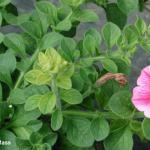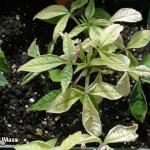How to Prevent Iron Deficiency in Iron Inefficient Greenhouse Crops
Iron deficiency is a relatively common problem among bedding plants and other spring greenhouse crops. The main symptom of iron (Fe) deficiency is chlorosis, which usually starts at the shoot tips, but more often occurs throughout the entire plant. Iron deficiency symptoms appear as interveinal chlorosis of the youngest foliage when new leaves expand before iron can be taken up by plant roots, because iron is a necessary component of chlorophyll synthesis. In all but the most extreme cases, iron deficiency can be easily mistaken for nitrogen or magnesium deficiency, so a soil or tissue test is necessary to confirm a suspected case of iron deficiency. In extreme cases, the leaves of some plants turn almost white.
Susceptible Crops
Some plants are inefficient at taking up iron from growing media, these include: Petunias (all types), Brachycome Daisies, Diascia, Nemesia, Scaevola Fan Flower, Paper Daisies, Argyranthemum, Calibrachoa, Scaevola, Ivy geranium, Piggyback Plant (Tolmiea menziesii), Basil, Pansy, Snapdragon and Catharanthus (vinca).
Deficiency Prevention
There are three main considerations for preventing Fe deficiency: pH control of the growing media, optimizing phosphorus fertilization, and the use of iron chelate treatments.
- pH Control: The key practice for promoting iron availability to plants is to maintain pH values in the acidic range, and\ the target pH range for iron inefficient crops is fairly low: 5.5 to 6.0. Most commercial soilless media have default pH values that approximate this range and in most cases, the use of an acid-forming fertilizer with a balance of ammonium and nitrate will be enough to maintain an appropriate pH level. A major exception to this rule occurs when the irrigation water is alkaline; in that case acid injection might be needed to counter the effects of excess alkalinity on pH. Also, if sphagnum peat-based growing media is being mixed in-house, then dolomitic limestone should be added at a rate of no more than 5 lbs/yd. Too much limestone is an aggravating factor that can result in elevated pH values and contribute to iron deficiency.
- Optimizing Phosphorus Fertilization: In certain circumstances, phosphorus (P) and Fe can react together to form insoluble iron phosphates. This reaction ties up iron because the iron in iron phosphate is not available to plants. The chemistry of this reaction is well understood in field soil, but has not been adequately studied in soilless media. To help ensure sufficient iron availability and also minimize the potential for adverse environmental impact, excess P fertilization should be avoided, especially for iron sensitive crops. Other useful practices to this end include not mixing superphosphate into growing media, use of an an acid other than phosphoric acid if acid injection is practiced, and, if possible, use of water-soluble fertilizer that supplies no more than 10% P (5% is a good rule-of-thumb) as the main fertilizer source.
- Iron Chelate: Fertilizing iron sensitive crops with Fe from time to time is probably the least complicated and most proactive way of preventing Fe deficiency.
Note that there are different forms of iron. Chelated forms are more available to plants at higher soil pH levels compared to iron that is in an unchelated form. Chelated forms of iron are bound to an organic molecule that helps keep the iron dissolved in the soil solution. As long as the chelate holds on to the iron, it is soluble and available for uptake by plant roots. There are also different chelates available, with varying characteristics. Studies have shown the following ranking of iron forms from most effective to least effective as a corrective drench at high pH:
- Iron-EDDHA which is effective at media pH above 7.0 (high solubility);
- Iron-DTPA is next in effectiveness;
- then Iron-EDTA;
- then Iron Sulfate (not a chelate, but an iron salt containg approximately 20% Fe).
All three chelates are soluble at media pH values of 4.0 to 6.0.
If iron is applied as a drench in a form that is not soluble because of high pH, then most of the nutrient will not be available to plants until media pH is lowered. In studies, iron sulfate tended to be less effective at increasing chlorophyll and resulted in more burning than iron chelates.
Sprint 330™ which is a commonly used product, contains 10% chelated DTPA iron. It performs best in slightly acid media with a pH of up to 7.5. Sprint 138™ is 6% chelated EDDHA iron for media with a pH over 7.0.
Verdanta OFE™ is an organic-based, water soluble, foliar iron fertilizer with seaweed extract that contains 3% iron.
Follow label directions for the product you are using. Sprint 330™ and similar Fe chelates are applied as a soil drench or as a foliar spray at the same rate of 4-8 oz./100 gal. (½-¾ tsp gal). The chelate is also soluble enough to make a concentrated solution for injection, but it must be mixed and injected by itself. The company advises not to pre-mix Sprint with pesticide or fertilizer concentrates. Soil drench is the safest method of application; foliar sprays should be tried experimentally first to check for injury or residues. At the recommended rate, Fe chelate can be applied every 3 or 4 weeks if desired. Rinse excess iron off foliage and flowers because concentrated iron can cause brown or black spots. Iron chelate is fast acting, and a response is typically apparent within a few days after treatment.
Special Considerations
The information in this fact sheet is intended only for those crops known to have a special requirement for Fe. Some growers struggle with spring crops which are susceptible to Fe toxicity rather than deficiency. These crops include marigolds, zonal geraniums, and seed geraniums and their nutrition should be managed to minimize plant-available Fe; essentially the opposite of the practices described above. This is done by keeping pH in a higher range and avoiding to much Fe fertilization. Applying the treatments described here to plants susceptible to Fe toxicity would be disastrous!
Prepared by:Dr. Douglas A. Cox
Plant and Soil Sciences
University of Massachusetts
Amherst
2000; updated 2012 Tina Smith, UMass Extension; updated 2019 Jason Lanier, UMass Extension
Links to Further Resources on the Web
- Identifying Nutrient Deficiencies of Bedding Plants by James L. Gibson, Paul V. Nelson, Dharma S. Pitchay, and Brian E. Whipker, North Carolina State University. 2001
- Iron Deficiency in Greenhouse Crops by Paul Fisher, University of Florida and Rick Yates, Griffin Greenhouse Supply Co. 2007
- Understanding Plant Nutrition: High pH Problems, Greenhouse Grower Magazine



